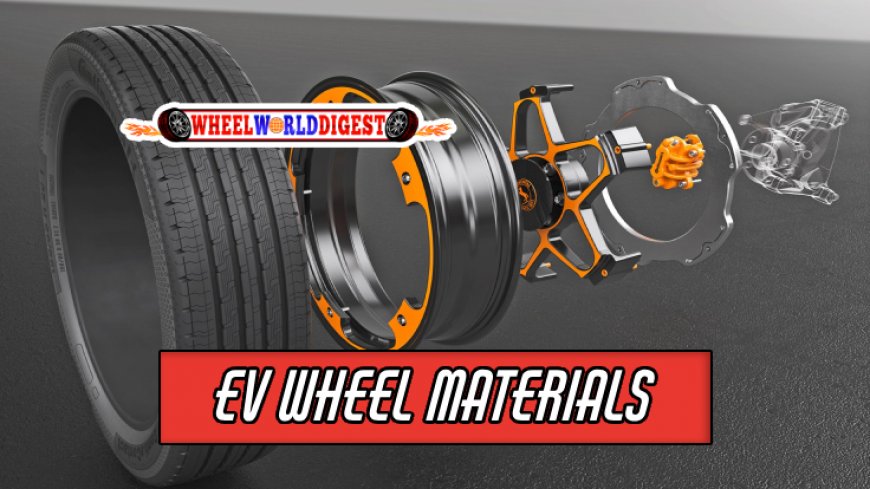Materials Making a Difference in EV Wheel Design
Learn about the advanced materials used in EV wheel design that contribute to vehicle efficiency and durability.

Imagine the world of EV wheels, where advanced materials are making a striking difference in design. They contribute significantly to vehicle efficiency and longevity, redefining the traditional concepts of automotive wheel design. As EV becomes an increasingly dominant part of the automotive industry, innovative materials and technologies at the heart of EV wheel design are unveiling new horizons of possibilities.
Unveiling the Advances in EV Wheel Materials
Fundamental changes in the functions and objectives of designing wheels for electric vehicles have triggered a shift in materials used. Dive into understanding these advanced materials that are setting new trends in the auto industry.
Table of Contents
- Material Evolution in EV Wheel Design
- Role of Lightweight Materials
- Widespread Application of Aluminum
- Benefits of Carbon Fiber
- Potential of Magnesium Alloy
- Impact on Aerodynamics and Efficiency
- Future Trends in EV Wheel Materials
Material Evolution in EV Wheel Design

Over the past several years, the materials used in wheel design have experienced a significant transformation, particularly in the electric vehicle (EV) sector. The boundless strive for lighter, stronger, and more efficient elements are transforming the way wheels are manufactured. The choice of material greatly impacts the overall performance of an EV. Consequently, manufacturers are increasingly seeking durable and lightweight materials.
The shift in materials represent more than just a technological upgrade. It signifies a broader movement towards sustainability in the auto industry, with many materials being recyclable and capable of reducing the vehicle's total energy consumption.
Role of Lightweight Materials
The need for lightweight materials in EV wheel design is primarily driven by the objective to enhance range and performance. Heavier wheels require more energy to move, substantially affecting an EV's power economy. Hence, manufacturers are prompted to choose lightweight materials that promise better energy efficiency.
- Aluminum: majorly used due to its lightweight and corrosion-resistant characteristics.
- Carbon Fiber: offers superior strength and lower weight than most metals.
- Magnesium alloys: being explored increasingly for their high strength-to-weight ratio.
Deep Dive into the Aluminum Role
Aluminum has earned its place as one of the most common materials in EV wheel design. This element guarantees a perfect blend of lightweight and strength, virility, and durability.
Aside from these, the benefits of using Aluminum include the ability to shape intricate wheel patterns–which can enhance aerodynamics.Not just that, manufacturers can now enjoy the ease of recycling Aluminum, positioning it well in the green manufacturing realm.
Widespread Application of Aluminum

The application of Aluminum in EV wheels is widespread. Many leading electric vehicle manufacturers have embraced aluminum due to its efficient energy consumption, reduced CO2 emissions, increased safety, and improved performance. Because of these factors, Aluminum has become the go-to material for most EV manufacturers.
For instance, the Tesla Model 3 characterizes its success through the use of Aluminum wheels. By opting for this lightweight metal, Tesla was able to maximize the overall range of its vehicles while maintaining high performance.
Relevance of Carbon Fiber in EV Wheel Design
Carbon Fiber is another material gradually gaining momentum in the EV wheel manufacturing space. Unlike Aluminum, Carbon Fiber is not a metal. It’s a composite material made from extremely thin strands of carbon atoms.
Carbon Fiber offers a superior strength-to-weight ratio compared to most metals, allowing wheels to be strong, lightweight, and highly durable. However, one of the significant challenges faced by manufacturers is the high cost of producing carbon fiber wheels.
Benefits of Carbon Fiber

Despite the cost challenges, carbon fiber stands out with a multitude of benefits that make it considered a material of the future in EV wheel design. Its high stiffness, low weight, and resistance to thermal changes are appealing, especially in extreme driving conditions.
Another noteworthy benefit of carbon fiber is its excellent fatigue properties. This means carbon fiber wheels can withstand repetitive loads and retain their strength over time, an essential characteristic for long-term wheel performance.
Understanding the Role of Magnesium Alloy
Magnesium works its magic as well in the evolving EV wheel design. Though less commonly used today, Magnesium Alloy presents a sound balance between weight and strength.
Beyond this, Magnesium alloy exhibits a great potential in heat dissipation, increasing the longevity of the tires. The use of magnesium combines these outstanding features with a more environmentally friendly manufacturing process, enhancing the overall sustainability of EV design.
Potential of Magnesium Alloy
Despite magnesium alloy's many benefits, its use comes with challenges. Magnesium is more expensive than aluminum, and it is more challenging to machine. Yet, recent advancements in magnesium alloying and processing have opened the door for its potential wider-scale adoption.
- Improved alloying techniques: have enhanced the durability and anticorrosive properties of magnesium alloys.
- Advanced processing methods: help in reducing production costs associated with this material.
Today, a handful of manufacturers and researchers are testing the boundaries and exploring the potential of Magnesium alloy for application in EV wheels. While we await widespread use, the initial results look promising.
Impact on Aerodynamics and Efficiency
![]()
The materials used in EV wheel design don't just affect the weight of the wheel. They also impact the vehicle's overall aerodynamics, thus playing a significant role in the vehicle's efficiency.
For example, aluminum and carbon fiber allow manufacturers to create more aerodynamically efficient wheel designs without sacrificing strength. These intricate designs help reduce air resistance and improve overall vehicle efficiency, leading to better mileage and lower energy consumption.
Innovative Wheel Designs
Leading EV manufacturers are constantly experimenting with innovative wheel designs. Some of these companies, such as Tesla with its Aero Wheels and Rimac Automobili with its aerodynamics-focused design on the C_Two, share the goal of maximizing mileage and enhancing overall performance.
Future Trends in EV Wheel Materials

As the demand for electric vehicles continues to surge, the quest for more advanced, sustainable, and efficient wheel materials will keep advancing. From lightweight materials like aluminum and carbon fiber to the promising potential of magnesium alloys, there are several exciting trends to watch out for:
- Use of Composite Materials: We may witness an increased use of composite materials such as carbon fiber and glass fiber, despite their high production cost.
- Expanded Application of Magnesium Alloys: We could see greater use of magnesium alloys in the future, thanks to improved alloying and reduction in production costs.
- Innovative Wheel Designs: We will continue to see innovative wheel designs that optimize aerodynamics and efficiency, further maximizing the range of EVs.
Overall, the future wheel designs of electric vehicles will be an exciting blend of innovation, environmental responsibility, and performance excellence, all driven by the choice of materials.
What's Your Reaction?









































































